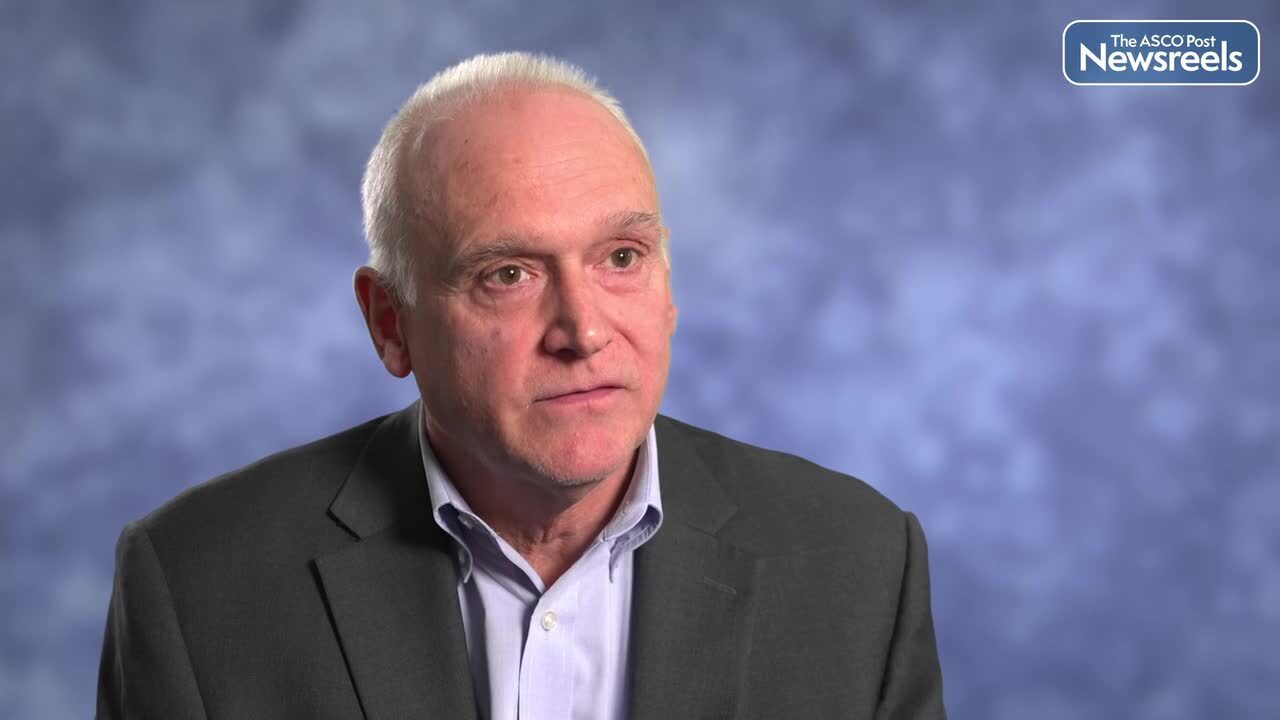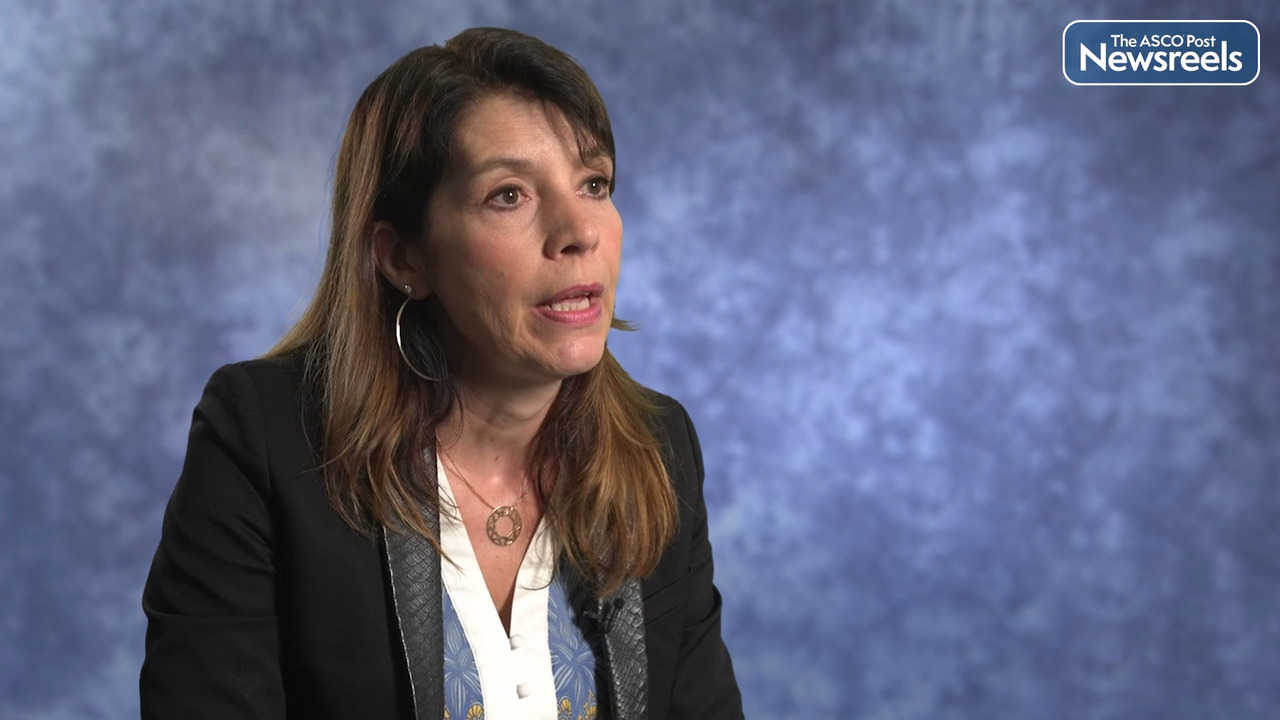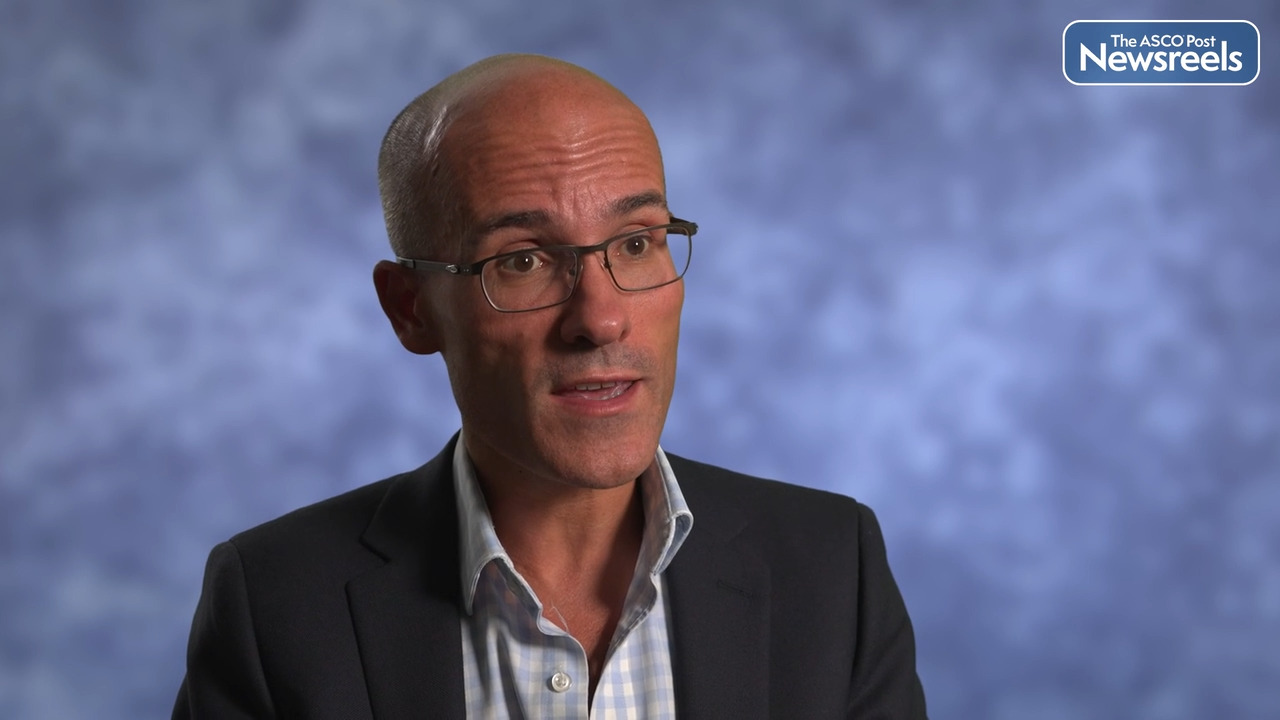Transcript
Disclaimer: This video transcript has not been proofread or edited and may contain errors.
PIVOT-09 is a phase III trial in advanced clear cell renal cell carcinoma in the first-line setting. This was a large, multicenter, international study of bempegaldesleukin, which is PEGylated IL-2, also abbreviated as BEMPEG, plus nivolumab, the anti-PD-L1 antibody, versus a TKI of investigators' choice. We chose suntinib or cabozantinib.
The primary population was patients with intermediate- or poor-risk by IMDC. The two core primary endpoints we set for this trial were objective response rate and overall survival. Again, in the primary patient population, intermediate-risk/poor-risk by IMDC.
Now the choice of the comparator arm, TKI, was based on the fact that by the time we launched the study, which was in 2018, only the results of CheckMate 214 were available. Which showed superiority of nivolumab and ipilimumab as first-line therapy versus suntinib, the comparator at that time.
But nivolumab and ipilumumab, as a regimen, was not approved in many countries at the time this trial was launched. So it was acceptable to use a TKI as a comparator. And we did give the choice to investigators to choose between suntinib or cabozantinib, because we realized that suntinib would not be, in the United States at least, an acceptable comparator in patients with intermediate or poor risk. So that's why, in the United States, physicians or investigators had the option to randomize their patients to cabozantinib. But of course, cabozantinib was not approved in many countries as first-line therapy, hence suntinib. So this was a 623-patient phase III trial that randomized patients to receive bempegaldesleukin, BEMPEG, the PEGylated IL-2, plus nivolumab, versus TKI of choice.
Now, why BEMPEG, in combination with anti-PD-L1? As you know, high dose IL-2 was approved by the FDA in 1992 based on consistent, durable CR rate of 68% and durable CRs in about 85% of those patients. So it was really important to use a friendlier, less toxic interleukin-2 compound in combination with immune checkpoint inhibitors. Immune checkpoint inhibitors became the standard of care, mainstay therapy for patient advanced clear cell RCC in the first-line therapy.
So what's the difference between PEGylated IL-2 in this instance? BEMPEG versus high-dose IL-2? High-dose IL-2 had a short half-life of 20 minutes, had to be given in the hospital under strict monitoring, usually in the ICU setting. It was difficult to combine with anything else. It was, more importantly, very toxic, as many of you know, with a refractory hypertension, capillary leak syndrome, et cetera. So PEGylated IL-2, BEMPEG, had six PEGs, and when given intravenously it hydrolyzes. And the two active PEG moieties signal through the interleukin-2 receptor beta and gamma, away from the alpha subunit of the PEGylated IL-2 receptor. And we all know that the alpha subunit of IL-2 receptor is the one that leads to toxicity. So the rationale, the mechanism of action of BEMPEG is it recruits T-cells to the tumor microenvironment. It expands the CD8+ T-cells, proliferates and activates them, while suppressing or being away from Tregs.
And unfortunately, despite the rationale, which we believe was the robust one, despite the fact that in a phase I trial, premier results showed really impressive, promising activity with the combination of BEMPEG plus nivolumab in patients with advanced RCC who received this combination as first-line therapy. We were hopeful that the results will be positive in this trial that had TKI as comparator. Unfortunately, the results came back and I presented those results at the ESMO meeting in Paris a week ago.
The objective response rate, which was the first co-primary endpoint, was 23% for the combination of bempegaldesleukin, versus 30% for the TKI. Importantly, the progressive disease rate was 29% with the combination of bempegaldesleukin plus nivolumab, versus 14% with suntinib. And those results were consistent with what was reported previously in first-line with the four first-line phase III trials, of nivoipi, CheckMate 214, and the three IO-TKI trials in first-line. So really it was no surprise what the TKI produced, but obviously was disappointing to have the results of bempegaldesleukin plus nivolumab not showing a superior ORR, which was really our aim. Our aim was, in patients with intermediate-risk/poor-risk disease, to show a increase in ORR from 26% with the TKI to 42% with a combination. This didn't happen. In fact, the ORR was lower with the combination of BEMPEG/nivolumab versus TKI.
Now the second co-primary endpoint was overall survival. Again, in this phase III trial of 623 patients in the primary patient population of intermediate-risk/poor-risk, there was no significant difference in OS between the two treatment arms.
Now coming to safety. The one silver lining about this trial in favor of the combination is that the BEMPEG/nivolumab arm produced about 50% fewer Grade 3/4 adverse events compared to the TKI. But discontinuation rate due to adverse events in both treatment arms was low at about 7%.
Now, we will report in the future the results with intent to treat as well as in favorable risk, as about 109 patients with favorable risk were recruited to the study. There will be no further development of this compound, bempegaldesleukin, as two other trials that were registrational, one in phase III, one as a first-line therapy in melanoma, was negative. This was also presented at ESMO by my colleague at MD Anderson, Dr. Adi Diab. That trial had BEMPEG plus nivolumab versus nivolumab in first-line therapy of patients with melanoma. There was also a single-arm study in 110 patients with low PD-L1 tumors in bladder, which was also negative.
So unfortunately, the bempegaldesleukin program will not continue further here based on those three negative phase III trials. However, it is my hope that the IL-2 pathway will not be shelved, that we will continue to explore other molecules. And there are in fact several biotech companies that are exploring still the IL-2 pathway. Because as we know, the IL-2 pathway is one validated pathway in melanoma and clear cell RCC, in addition to the established pathways of VEGF, mTOR, and of course the new checkpoint inhibitors.





